Comet CC/2020 F3 NEOWISE | |||
| « Previous | Back to Astrophotography Gallery | Next » | |
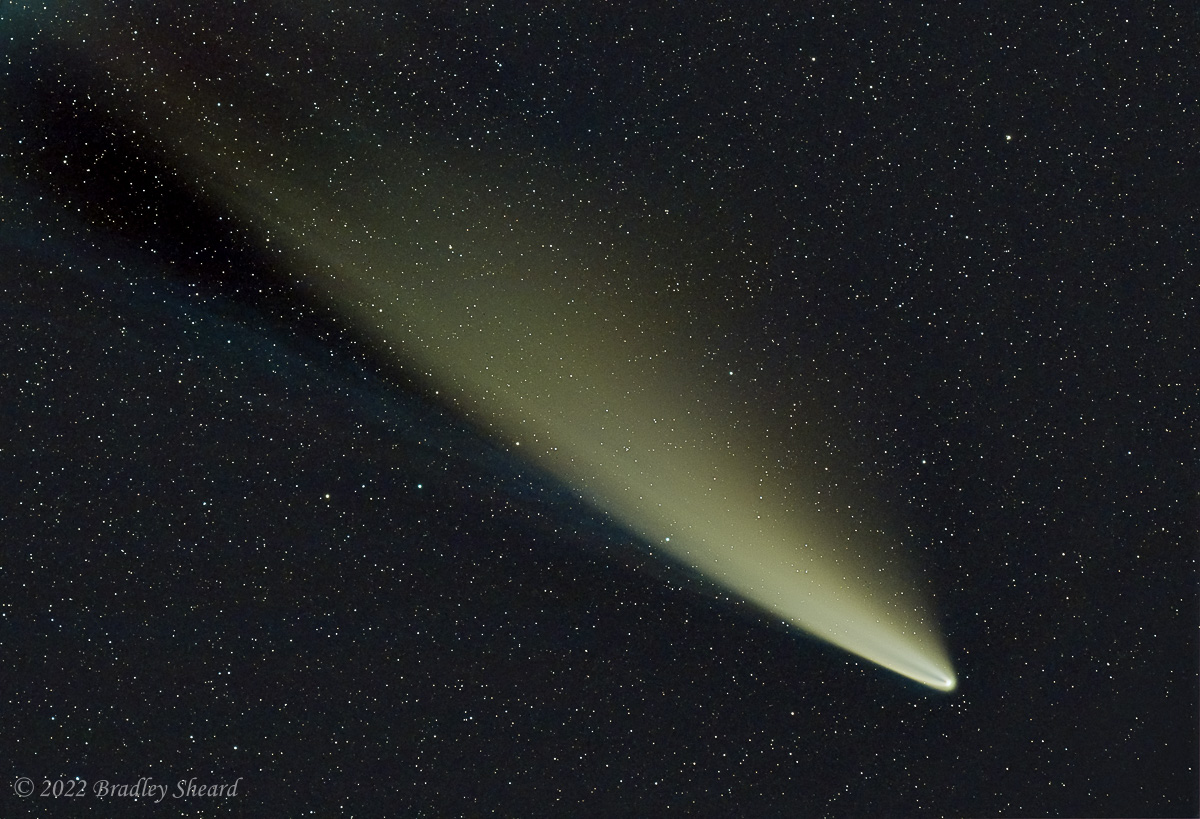 | |||
| Optics: | Williams Optics Star 71 f/4.9 | ||
| Camera: | full spectrum converted Sony A7R | ||
| Exposure info: | 17 x 15 secs | ||
| Filters used: | none | ||
| date: | July 12, 2020, 4:21-4:32 am | ||
|
Comet CC/2020 F3, commonly known as NEOWISE, was discovered on March 27 by NASA's Near-Earth Wide-field Infrared Survey Explorer (NEOWISE) satellite. The comet is believed to be about 3 miles in diameter. Comets are conglomerations of rock and ices, often called "dirty snowballs." They are generally in highly-elliptical orbits around the sun, spending most of their lives dormant in the outer reaches of the solar system. When they get close to the sun, however, the ices begin to sublimate, carrying dust and debris away from the nucleus and forming the long tail we associate with comets. Comets often have, as NEOWISE does, two tails. The bright, yellowish tail is formed mostly of dust and debris illuminated by sunlight, and carried away from the comet by the solar wind. (Note that the tail does NOT indicate the direction of the comet's travel.) This tail tends to be curved, pushed outward by the solar wind, while following an elliptical orbit about the sun. Thus the comet leaves behind a dust and debris trail that itself orbits the sun, and these trails are often the source of meteor showers we see here on earth. The second tail, a faint bluish color faintly visible int the photo above, but clearer in the second image below, is formed by positively charged ions (atoms stripped of their electrons), and is also blown away from the sun by solar wind, but due to their charge the molecules are forced to follow the sun's magnetic field lines, and thus the ion tail points directly away from the sun in an essentially straight line. | |||
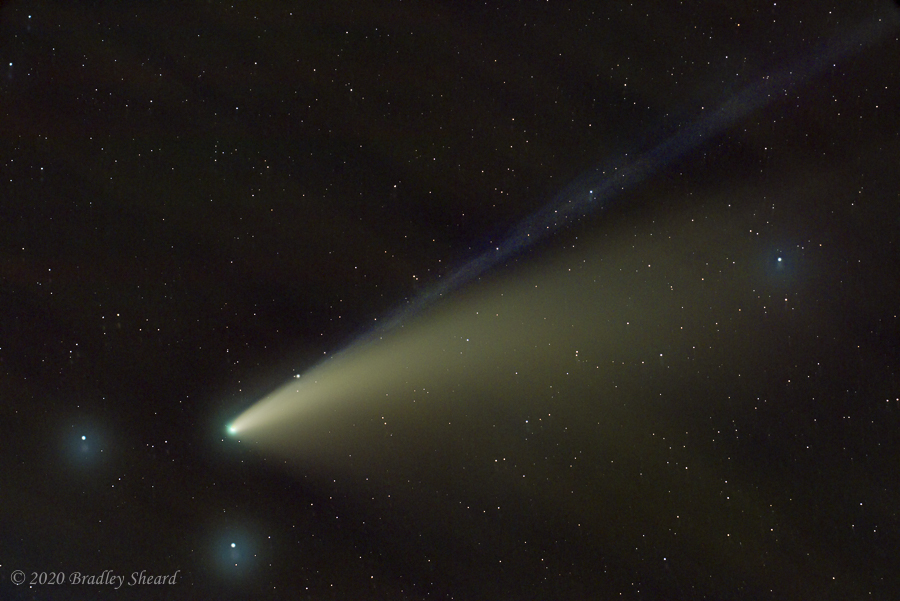 | |||
| Optics: | Williams Optics Star 71 f/4.9 | ||
| Camera: | full spectrum converted Sony A7R | ||
| Exposure info: | 90 x 15 secs | ||
| Filters used: | none | ||
| date: | July 18, 2020, 9:53-10:22 pm | ||
|
The trickiest part of photographing NEOWISE seemed to be that at it's brightest, it is mostly visible just after sunset and just before sunrise, due to its location close to the sun. Below are a couple of images taken just after dusk. | |||
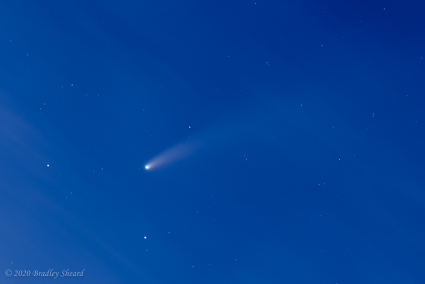 |
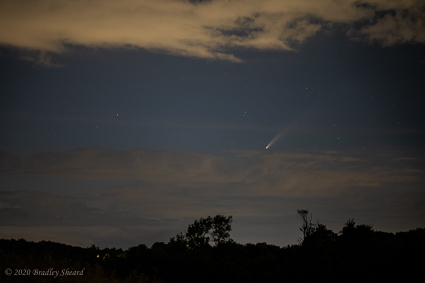 |
| Comet NEOWISE at dusk through thin clouds | NEOWISE at sunset at the Howard County Conservancy |
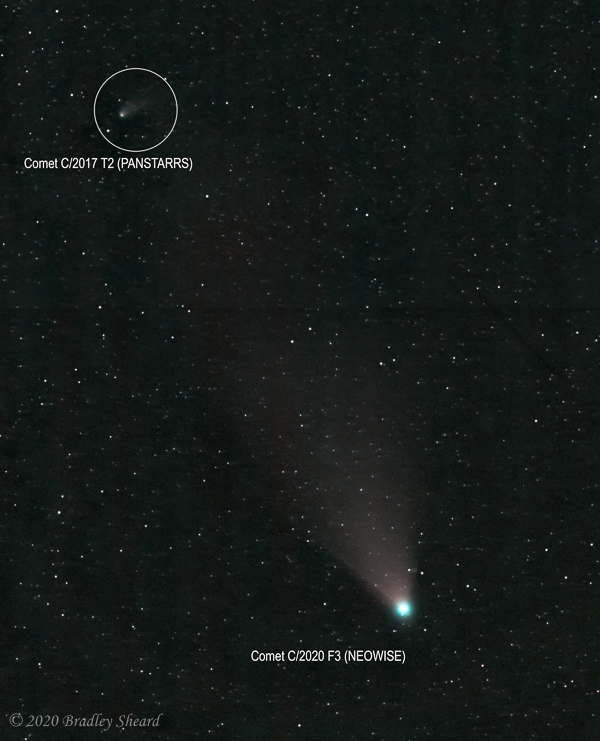 | |
| Two Comets: NEOWISE and PANNSTARS | |
| (Williams Optics Star71 and Sony A7R, 36 x 60 secs) | |
|
For a couple of days, as the much-watched comet NEOWISE faded and dimmed into the stellar blackness, there were two comets (actually 3) that could be seen, and photographed, in the same camera frame. This image was taken on the night of August 9, 2020, from Carrs Mill Park in Maryland. NEOWISE is clearly much brighter with a clear dust tail visible (and just a hint of the ion tail streaming straight away from the sun at the lower left edge of the visible tail), while PANSTARRS is far fainter, with just a smudge of a tail visible. The fascinating thing about this image, however, is that the two comet's tails do NOT point in the same direction! While NEOWISE's tail points away from the sun (as it should), PANSTARR's faint tail appears to point about 90-degrees from the sun (toward the upper right in this image). Just why this is so, I suspect is due to the 3D geometry of the orbits (both comets orbits are inclined significantly from the ecliptic)....and I did manage to confirm that the two tails do indeed point in different directions at the COBS database, as shown in the plots below. Note that in mid-August (image made on Aug 9, 2020), the tail position of NEOWISE was approximately 80-90 degrees, or nearly due East, while that of Panstarrs was approximately 330 degrees, or NNW. | |
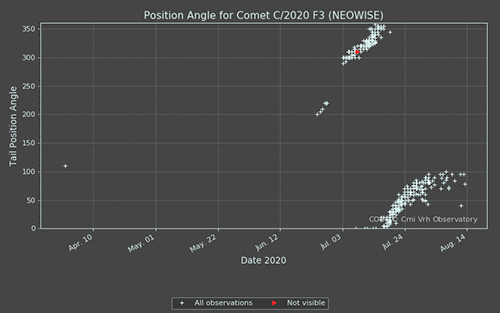 | 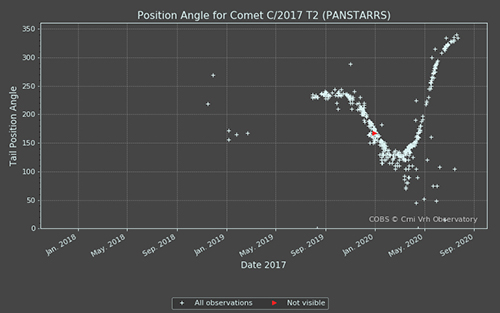 |
| Plot Credit: COBS Comet Observation Database - CC-BY-NA-SA 4.0 | |
| Comet Observation Database (COBS) | |
Below is an orbital plot (taken from 'theskylive.com') showing the orbits of both comets, as well as the earth and sun, on August 9, 2020. I have sketched in the approximate direction of each comet's two tails. The comet's tails are NOT in the direction of the comet's travel, as one my intuit, but are blown outward by the solar wind. The ion tail is shown in purple, and points directly away from the sun; the ion tail is made up of charged particles, and constrained to follow the sun's magnetic field lines, which generally point directly away from the sun. The dust and gas tail, shown in yellow, is initially blown outward by the solar wind, but since these particles have no electrical charge, they begin to follow their own orbital path around the sun. Since they are blown outward and now have a larger orbital radius than the comet, they move more slowly and the tail takes on its characteristic curved shape, away from the comet's orbital motion. Looking at the position of the earth in the plot, you can see that the angle of the sun-comet vector is significantly different from our line-of-sight vector for the two comets. In essence, we are looking more along the sun-comet axis for PANSTARRS than for NEOWISE, and I believe this is why the tails of the two comets do not appear to lie in the same direction from our vantage point. | |
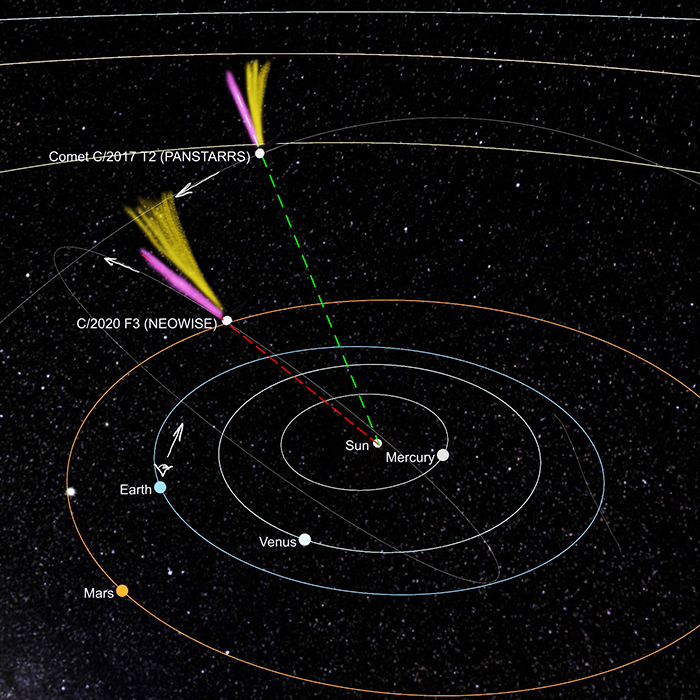 | |
| Orbits and position of NEOWISE and PANNSTARS on August 8, 2020 | |
| Plot Credit: The Sky Live | |
| The Sky Live | |
References
1. Pater and Lissauer, "Planetary Sciences," Cambridge University Press, 2015.